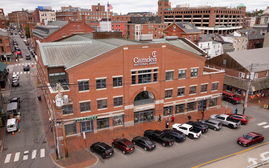
Loan rangers: Behind the scenes of the Paycheck Protection Program in Maine
 Photo / Tim Greenway
In the PPP loan process, Grandy Oats principal Aaron Anker was on the phone “until all hours” with Terry Trickey of Bangor Savings.
Photo / Tim Greenway
In the PPP loan process, Grandy Oats principal Aaron Anker was on the phone “until all hours” with Terry Trickey of Bangor Savings.
A mad scramble for money marked the April 2020 start of a $349 billion federal COVID-relief loan program that ran dry within two weeks. Afraid it wouldn’t even last that long, business owners deluged bankers with pleas for rapid issuance of the lifesaving loans.
“The biggest concern we all had was that the money would run out that first weekend,” says Aaron Anker, an owner and self-proclaimed chief granola officer at Grandy Oats, a Hiram-based maker of organic granola, trail mixes, roasted nuts and cereal that employs more than 30. “When the first round came out, I was on the phone with my banker until all hours.”
The banker was Bangor Savings Bank Vice President Terry Trickey, who had worked with Anker for the past 15 years. She helped Grandy Oats file the right paperwork at 2 a.m. on a Saturday, after a quick redo when the form changed for what was officially known as the Paycheck Protection Program. Approval came through the following Tuesday, allowing Anker and business partner Nat Peirce to pay furloughed staff, keep those still coming in safe and cover employees’ health insurance.
“Since then,” Anker says, “we’ve been able to bring back our current staff to levels similar to what they were before the pandemic. We wouldn’t have been able to do that without the PPP.”
Grandy Oats is among more than 28,000 Maine businesses that received $2.3 billion in PPP loans in 2020, helping support more than 250,000 jobs.
This year through March 21, more than 12,000 loans were approved in Maine worth nearly $800 million (see graphic for exact numbers).
Anything but routine
The program, administered by the U.S. Small Business Administration, has been anything but routine for banks. Behind the scenes, commercial and business bankers — some new to SBA lending — and colleagues from other departments answered queries and processed paperwork around the clock. Along the way and working largely from home as branches were closed, they navigated new rules that were constantly in flux, handling urgently needed loans in volumes that were exponentially higher than normal times.
As Trickey thinks back with a reference to post-traumatic stress disorder (“I’m only half-kidding”), she considers it the most trying time in her 40-year banking career but also the most rewarding, saying, “I feel like what I did truly made a difference for many people and many businesses.”
So does Marjorie McAvoy, who processed first-round PPP loans at Androscoggin Bank and now manages Biddeford Savings’ Scarborough branch.

Frustrated when she didn’t know the answers to all her clients’ questions or when they didn’t qualify for PPP relief and she offered alternatives, she says, “I made sure everyone got what they needed.”
Rescue relief delivered by banks
The Paycheck Protection Program is an SBA-backed forgivable loan program created at the start of the pandemic by a $2.2 trillion federal stimulus bill known as the Coronavirus Aid, Relief and Economic Security, or CARES, Act. Its goal: To help businesses keep staff on the payroll during the pandemic right after mandatory closures went into effect, threatening their survival.
In the words of Maine Bankers Association CEO Chris Pinkham, “PPP was a rescue, a temporary cash infusion to carry the shock of no work, no income through an unknown period of time until the pandemic was under control.”
Initially, it allowed qualified borrowers to cover up to eight weeks of payroll taxes plus benefits as well as other costs including rent and utilities and mortgage. That period was later extended to 24 weeks.
The program got off to a bumpy start, running out of the original $349 billion within the first two weeks, then restarted with $320 billion via a second piece of legislation. One of the reasons the money was quickly depleted was the widespread uncertainty at the start of the pandemic, prompting even large employers to chase any funding they could; that included Economic Injury Disaster Loans, which also ran out of appropriated funds early on.
With the PPP, there was also blowback about some of the country’s largest restaurant and hotel chains unfairly squeezing out struggling small businesses though many reportedly returned or cancelled those loans. More recently, the Government Accountability Office has called for more planning and SBA oversight of the program, which is due to wrap up on May 31.
Administered by the SBA with support from the U.S. Treasury Department, the program relies on banks to do the heavy lifting.
On how it worked in practice, Pinkham says, “The federal government delivered the money, and financial institutions coordinated the applications, the processing of the loans and ultimately, the forgiveness of the debt, through a massive process of data collection and transmission. Banks delivered the results of the PPP program to Main Street.”
Community banks nationwide punched above their weight, as noted in a December 2020 report by the Conference of State Bank Supervisors.
In Maine where all but four of the state’s top 20 banks by deposit market share are Maine-based community banks, even bankers new to SBA lending stepped outside their comfort zone to help desperate customers. The first few months were the most intense, testing nerves and stamina.
“When you talk with somebody who is so close to thinking their business is going to go under, and they need answers, you’re not thinking about burning out,” says Andrew Silsby, president and CEO of Augusta-based Kennebec Savings Bank. “That’s adrenaline. We were called upon to answer questions and to help people get through this process, and we weren’t going to stop until we got everybody through this.”
Diane Sturgeon, deputy district director of the Maine SBA District Office, feels the same, saying, “One of the things I love about being in Maine is everyone just pitches in to help and get the job done when we need to help each other out.” That includes banks processing loans as low as $500 “because their customers needed it.” Of her own round-the-clock efforts, she says, “I’ve never been big on sleep anyway.”
Business banking’s ‘wild ride’
For bankers processing the loans, the first few months were the most intense, recalling experiences like modern war stories of the financial world.
“Culture shock” is how Jeff McNally describes his involvement in processing PPP loans at Gorham Savings Bank, months into his tenure as a retail banker.
“Working at the branches, I went from a really hustle-and-bustle atmosphere of dealing with customers and seeing the entire building empty except for the drive-through.” That was at Gorham Savings’ Portland waterfront headquarters, where McNally was part of a team that handled more than 1,100 PPP loans in 2020.
When he arrived at 8 a.m., there were colleagues three hours into their day and working around the clock.
“I’d see emails from people at midnight, 1 a.m., just trying to get a handle on all those loans,” he remembers. Though he missed the customer contact, he liked business banking and colleagues he got to know so much, he applied for a loan administrator position he started in October.
“I really like business banking and I’m glad I’m here now,” he says.
Kim Donnelly, Gorham Savings’ business banking director and a senior vice president, says that having “all hands on deck” from people across all roles was the ultimate cross-training and team-building exercise.
“You have such pride in your bank, and community banks in general, for moving so quickly,” she says. “Everyone was willing to be there, working from home till all hours of the night, because they knew these customers.”
She adds that Gorham Savings was one of few banks willing to take on new customers seeking PPP loans, and that the number of PPP loans in 2020 exceeded the number of total business loans for all of 2019. Similarly, Bangor Savings handled 4,843 PPP loans in 2020, compared to 80 SBA loans in a typical year.
“There were days when [the program] ran out of money, and that’s when my anxiety would be up,” says Bangor Savings President and CEO Bob Montgomery-Rice. “By the end of the last tranche, I think we got everyone who needed money.”
Kennebec Savings Executive Vice President and Chief Operating Officer Craig Garofalo remembers PPP’s early days as a “wild ride” not limited to people in commercial banking, adding, “It was a rallying cry for a lot of team members.”
A father of four young children, Garofalo barricaded himself in his bedroom last March with a laptop, putting in 15-hour days on behalf of anxious customers. Many showed their appreciation after a loan came through, including one who dropped off beer in his driveway.
“You feel a little bit like a hero at some level,” he says.
Appreciative customers include Steve Lachance of the Quarry Tap Room in Hallowell, which employs close to 40 people in the off season and secured two PPP loans through Kennebec Savings, its longtime bank.

“Especially in today’s world,” he says, “it’s nice to have that home-town bank where you know the individuals, and their families come in to eat at your restaurant. It comes full circle.”
There was a similar team spirit at Camden National Bank that vice president and commercial portfolio manager Libby Arrico likens to football: “You do your part, and you kick the ball down the field.”
She says bankers talked to every client even if they didn’t want a PPP loan, and that she gained new appreciation for loan document processors after doing it herself but adds, “I hope to never see something like 2020 ever again.”
Similarly, Camden National President and CEO Gregory A. Dufour, says, “The challenge of the past year reinforced to me the need for leaders to delegate and empower those around us — the results are amazing.”
Chris Fitzpatrick, a Machias Savings Bank executive vice president who leads business banking from Houlton, cites “the herculean efforts of an awful lot of people” at his bank, which closed more than triple its normal commercial loan volume in 2020 because of PPP. He’s also thankful to his wife for “pumping me full of coffee and keeping me going.”
Turning the page
As the PPP program winds down this spring, business owners are sounding more optimistic about 2021.
“We had a really strong March, we have a great team, and we’ll definitely be adding to it this year,” says Anker, of Grandy Oats.
At the Quarry Tap Room overlooking the Kennebec River in Hallowell, Lachance was equally upbeat, amid preparations for subdued St. Patrick’s Day festivities — a year to the day after its pandemic shutdown — and looking forward to warmer weather.
“You’re still tied to all the restrictions, but hopefully by June or July things will open up and start getting back to normal,” he says. “Until then, we will stay masked and distanced and do the best we can.”














0 Comments